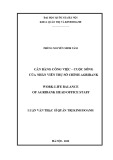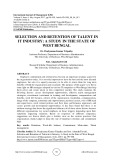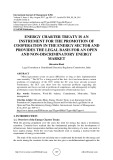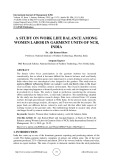
http://www.iaeme.com/IJM/index.asp 109 editor@iaeme.com
International Journal of Management (IJM)
Volume 8, Issue 4, July–August 2017, pp.109–117, Article ID: IJM_08_04_014
Available online at
http://www.iaeme.com/ijm/issues.asp?JType=IJM&VType=8&IType=4
Journal Impact Factor (2016): 8.1920 (Calculated by GISI) www.jifactor.com
ISSN Print: 0976-6502 and ISSN Online: 0976-6510
© IAEME Publication
ENERGY CHARTER TREATY IS AN
INSTRUMENT FOR THE PROMOTION OF
COOPERATION IN THE ENERGY SECTOR AND
PROVIDES THE LEGAL BASIS FOR AN OPEN
AND NON-DISCRIMINATORY ENERGY
MARKET
Shivanku Bhatt
Legal Consultant at Uttarakhand Electricity Regulatory Commission, India
ABSTRACT
“Mixed agreements create no great difficulties as long as their implementation
runs smoothly.” The ECT is a living proof of this fact. As it has been shown, certain
problems of compliance of the ECT within the EC area have already aroused.
Furthermore, the ECT case show how the recurrent problems regarding mix
agreements and Laws can lead to problems of competence, and subsequently to highly
problematic issues like the substantive fragmentation of International Law.
Key words: Retention, Work-life balance, Commitment, Motivation, Talent
management.
Cite this Article: Shivanku Bhatt, Energy Charter Treaty is an Instrument for the
Promotion of Cooperation in the Energy Sector and Provides the Legal Basis for an
Open and Non-Discriminatory Energy Market. International Journal of Management,
8 (4), 2017, pp. 109–117.
http://www.iaeme.com/IJM/issues.asp?JType=IJM&VType=8&IType=4
1. INTRODUCTION
1.1. Overview of the Energy Charter Treaty
With the growing population over the years the need for energy has taken a tremendous
transition. Countries have realized that the fundamental principle for the development of
infrastructure, better transportation facilities and protecting the territory of a state, one need to
have surplus energy. From the very basic household work to making a nuclear bomb the
requirement of energy is inevitable.
The topic of the study does not only help one to understand the demand for the energy and
the tussle among the countries for the same but also gives a multidimensional approach to the

























